Physical Address
304 North Cardinal St.
Dorchester Center, MA 02124
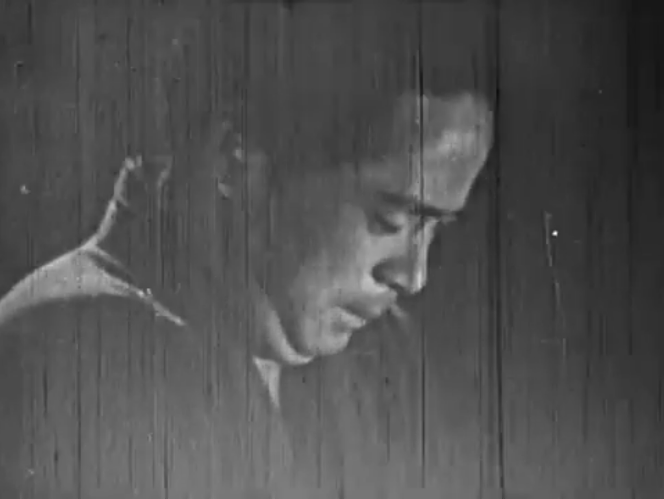
| Production Company | Nikkatsu (Tamagawa) |
| Scenarists | Yagi Yasutarō (adaptation); Kameya Gentoku (screenplay) |
| Source | Ozaki Shirō (novel) |
| Cinematographer | Yokota Tatsuyuki |
| Performers (Note: actors credited in the cast list but who don’t appear in the extant version are noted with an asterisk.) | Kosugi Isamu (Hyōtarō and adult Hyōkichi), Yamamoto Reizaburō (Kira Tsune, a yakuza), Yokoyama Unpei (Jin), Yoshida Kazuko (Omine, Hyōtarō’s wife), Tobita Kisao (Hyōkichi as a child), Furuya Hisao (Hansuke), Mizutani Yoshikazu (Sampei as a child), Kikuchi Ryōichi (Natsumura), Hajime Hikari (Shinkai Kazuhachi), Nakamura Kichiji (Monk), Suzuki San’emon (Uezono), Murata Chieko* (Osode), Kuroda Kiyo* (Orin), Kosugi Bonsaku* (Toda-san, a teacher) Yōko Benisawa* (Orin’s mother) |
| Status | Partially extant (about 40 percent) |
| Photography | Black and white |
| Sound | No |
| English Subtitles | No1 |
| Original Release Date | February 13, 1936 |
| Length | 46 minutes (originally 118 minutes) |
| Awards | Kinema Junpo “Best Ten” Award: #2, 1937 |
(Note: The following reflects the narrative of the film as it currently exists, rather than the film first released to theaters in 1936, which was more than twice as long – it ran nearly two hours – and which, furthermore, was apparently a sound film in its original form, rather than a silent film with intertitles (see Commentary and Analysis below for details). It should be noted that important incidents and even crucial characters from the original version (e.g., Osode, the protagonist’s love interest, played by Murata Chieko) are completely missing from this version of the film and thus are not covered in the narrative below. The author of this blog would like to thank Hayley Scanlon for providing not only an English translation of the intertitles in the existing print, but notes derived partly from her reading of Ozaki Shirō’s novel.)
During the Meiji era, around the time of the Russo-Japanese War (1905), an aging yakuza, Aonari Hyōtarō, on his estate, Tatsumiya, together with his young son, Hyōkichi, stands in his front yard next to a giant tree. Hyōtarō orders Hyōkichi to climb the tree, but the boy is afraid. The man urges him to “try harder,” and, with the incentive of the gift of a pistol as reward, eventually the boy climbs almost to the top of the tree. When Hyōtarō asks the child what he sees from his vantage point, Hyōkichi says he sees “a parade with flags,” implying that he’s watching a military parade.
Sometime later, Hyōkichi gets into an argument with Sanpei, the bullying son of the local watchman, Jin. Sanpei deliberately calls Hyōkichi by a wrong name (“Hyotan”) and when they come to blows, Sanpei beats Hyōkichi, and is in turn knocked down by one of Hyōkichi’s servants, Hansuke. Jin arrives and, on behalf of his son, threatens to beat Hyōkichi, but a local yakuza, Kira Tsune, whose boss is Hyōtarō, intervenes to defend Hyōkichi and Jin relents. Jin brings Sanpei (very reluctantly) to Tatsumiya to apologize to Hyōtarō, and the old man publicly accepts this apology.
Privately, however, Hyōtarō calls his son a coward for allowing Sanpei to get the better of him in a fight. The father removes from a drawer the pistol he had previous offered to the boy for climbing the tree. Still holding the pistol in his hand, Hyōtarō calls the frightened boy into the front yard. Standing beside the tree, the father smiles affectionately and predicts that the two of them will “fire [the pistol] every day from tomorrow.”
While Hyōkichi is away at school, Hyōtarō receives a letter from the school tutor citing some unspecified problem with the boy’s behavior and requesting his presence at the school on a certain date.2 When Hyōtarō arrives, he hears someone singing a bawdy song, and finds his son in a room near a table where a pack of cigarettes lies. Hyōkichi swears to his father that it was a friend, Natsumura, not he, who was singing, and that the cigarettes are also Natsumura’s. His father beats him, however, because he had always told him never to smoke or sing bawdy songs and he doesn’t want him associating with those who do. Hyōtarō tells his son that he must go his own way and not do what everybody else does, and points out how much he is sacrificing so the boy can attend school.
Some years later, an older Hyōtarō is standing near the tree in the front yard beside a smiling young man: the adult Hyōkichi. Hyōkichi tells his father that he wants to attend university in Tokyo so as to get into politics through journalism. When the father asks his son how he will get the money to do this, he replies that he intends to work his way through school and live in his friend Natsumura’s boarding house. Hyōtarō, horrified, tells his son that he can’t live in a place like that and that he must never be dependent upon people outside the family. The father resolves that “As long as I’m alive, I’ll support you through school.”
At the university, Hyōkichi from a classmate hears news about a plan to erect on school grounds a statue depicting the wife of the institution’s president. The students are outraged by this scheme, considering it an instance of corruption. Hyōkichi makes a speech in class, demanding that the statue instead depict a beloved professor who had embodied the values of the school. The whole class cheers his speech. Later, in his rooms, Hyōkichi is visited by classmates sympathetic to his idea, and they drink together and resolve to form an “anti-statue” committee.
Meanwhile, at Tatsumiya, Hyōtarō mortgages his entire estate for a large sum of money to send to his son, and it’s clear from his conversation with Jin, who is negotiating the deal, that he’ll never be able to pay off this mortgage. After he seals the deal and receives the money, Omine, his wife, looks worried and asks if he knows what he’s doing, because “we have nothing left.” The old man calmly replies that, “Once our son is a man, we won’t need to worry about the estate.”
Back at the university, Hyōkichi and some friends, with somber expressions, are seen walking through a forest. Title cards explain that the anti-statue movement had split into factions, and that the members of Hyōkichi’s faction – including Hyōkichi himself – have been forced to drop out of school. He and the other young men sing or shout the word “Fools” as they walk.
Kira Tsune, just released from prison for murdering a gambler, arrives at Tatsumiya to find his boss Hyōtarō on his sickbed. Kira Tsune converses with Hyōtarō, who is proud of his son’s rebellious stance against the school authorities, though it cost him his education.
Kira Tsune confronts one of Jin’s men, who has apparently come to Tatsumiya to collect on a debt, ordering this man to leave Tatsumiya and never come back. Hyōtarō composes his will. Suddenly, in the next room, Kira Tsune hears a gunshot, and he and Omine rush in to find that Hyōtarō has shot himself. They try to bind up his head wound, but the old man dies.3
Arriving home, Hyōkichi is greeted by his grieving mother. Kira Tsune also greets him and, at his mother’s urging, Hyōkichi thanks him for his dedicated service to his father. The yakuza presents Hyōkichi with the gift his father left him – the pistol – and the young man is overcome with grief. He and his mother read the will, in which the father had written, “If you become a man who can hold his head high, it’s as good as rebuilding the family name.”
A servant informs Hyōkichi that Kira Tsune has left to meet a man named Matsu no Kimura for some sort of confrontation with the latter’s family. The young man runs after Kira Tsune, but is stopped by a monk from a temple who recognizes him. Meanwhile, Kira Tsune arrives at the meeting place and confronts his adversaries.
Hyōkichi asks the monk to carry out the instructions in his father’s will. He also wants all the estate to go to the creditors, insisting that he can get by on his own. The monk is impressed by Hyōkichi’s determination to carry on his father’s values.
Hyōkichi sees Kira Tsune running past and follows him to Tatsumiya. The latter confesses that he murdered someone. Hyōkichi invites him inside the house to hide, and the yakuza is deeply moved by his friend’s generosity.
Jin and one of the dead man’s creditors, Uezono, arrive at the house for the wake. Jin tactlessly asks Hyōkichi to pay back the father’s debt to Uezono. Hyōkichi suggests that they wait until after the funeral, so he can meet with all his father’s creditors to negotiate with them, but Jin rejects this offer. Hyōkichi says that this day should only be one of remembrance for his father and that he doesn’t wish to discuss the estate at that moment. Jin then requests a statement in writing from him.
Instead of complying, Hyōkichi refers to the only thing his father left him that matters: “the most precious thing at Tatsumiya.” He removes the pistol from his kimono and places it on the floor between himself and the two men. Jin and Uezono, frightened, quickly depart. Kira Tsune comes out from his hiding place and assures Hyōkichi that his actions would have been exactly what his father would have wanted. The monk laughs at Jin’s discomfiture.
A “for sale” sign appears in front of the house. From a hill, Hyōkichi and Omine gaze out over the estate, presumably for the last time.
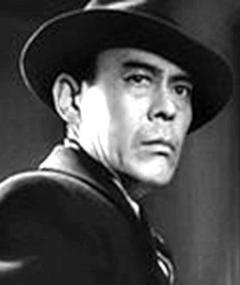
Yamamoto Reizaburō began his film career in 1927. Before appearing in this movie, he acted in both jidai-geki action films, such as Jirokichi the Rat (Oatsurae Jirōkichi kōshi, Itō Daisuke, 1931) and comedies, such as Sazen Tange and the Pot Worth a Million Ryō (Tange Sazen yowa: Hyakuman ryō no tsubo, Yamanaka Sadao, 1935). After Theater of Life, Yamamoto had a small role in Uchida’s Earth (Tsuchi, 1939) and also appeared in the director’s lost two-part epic History (Rekishi, 1940). Yamamoto’s most famous movies by far are the two he made in the immediate postwar era for Kurosawa Akira: the award-winning Drunken Angel (Yoidore tenshi, 1948) and the classic Stray Dog (Nora inu, 1949), in both of which he portrayed sinister underworld figures. He also acted in works by many other prominent postwar filmmakers, including Honda Ishiro (The Blue Pearl (Aoi shinyu), 1951, the director’s feature debut), Naruse Mikio (Older Brother Younger Sister (Ani imōto, 1953)) and Shinoda Masahiro’s classic Pale Flower (Kawaita hana, 1964). In his memoir, Kurosawa provides a memorable account of his first meeting with Yamamoto: “I had never seen eyes as frightening as his, and when I first met him I was afraid to get close enough to carry on a conversation. When I finally did talk to him, I was surprised at what a fine human being he was.”4 He died in 1964.
(Note: The poor quality of the screenshot images included here reflects the quality of the source print, which is extremely dark and badly damaged. We apologize to the reader for this.)
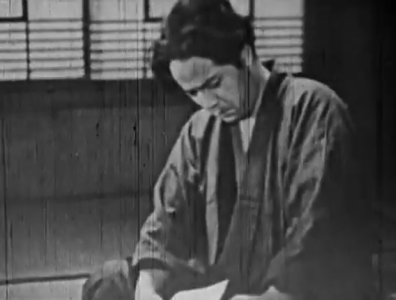
This movie, which is about a failure, was the 37-year-old Uchida Tomu’s most prestigious success up to this point in his career. It was the first film the director completed after his return to Nikkatsu, following the release of four films, including the brilliant Police Officer (Keisatsukan, 1933), that he’d made for Shinko Studios during the period 1933-35. Theater of Life: Youth Version established him as a pioneer in the new Pure Literature, or junbungaku, movement – directors Gosho Heinosuke and Toyoda Shirō were also part of this movement – which advocated for the cinematic adaptation of modern Japanese literary masterpieces, as opposed to ancient classics like The Tale of Genji or the plays of Chikamatsu.5 This movement in turn inaugurated a long tradition in which the Japanese would become among the world’s most intelligent and sensitive adapters of their own countrymen’s modern literature. One need only compare their films to what Hollywood has done over the years with, and to, classic American literature to recognize the superiority of the Japanese in this underappreciated genre.6
With this film, Uchida’s status was elevated in the eyes of critics from an intelligent and promising young director to a mature master, whose name could be invoked in the same breath as those of Ozu or Mizoguchi. The proof of this can found in the fact that, over the four-year period of 1936 to 1939, inclusive, four films of his placed within the top five in the Kinema Junpo (KJ) “Best Ten” critics’ poll: this film, which was ranked second for 1936;7 The Naked Town (Hadaka no machi, lost), ranked fifth for 1937; Unending Advance (Kagirinaki zenshin, partly extant), ranked first for 1937; and Earth (Tsuchi, partly extant), ranked first for 1939. Uchida, at least in Japan, would never again be perceived as a minor figure.
So it’s a great shame that this very significant work now exists as a mere fragment containing less than half of the originally-released film, and even within that fragment, major characters and entire important subplots have gone missing. This is also the penultimate Uchida film which survives as a silent film with intertitles. Even in Japan, whose transition to sound proved much more gradual than America’s or Europe’s, 1936 was an exceptionally late date for a silent film to be released by a major studio. The Only Son (Hitori Musuko), the first talkie directed by Ozu, who was one of the last major Japanese directors to embrace sound, was released later that same year, and his last silent movie, College Is a Nice Place (Daigaku yoi toko, lost) also came out that year.8
However, this blog page claims that the original version of Theater of Life was released as a sound movie. Therefore, the silent version with intertitles that has survived was probably only an edited version of the official release. It seems very likely that this extant version was specifically prepared by the studio, Nikkatsu, to be viewed in those theaters in non-urban areas not yet wired for sound, though it’s unclear why the film was so drastically truncated. (Crown of Life (Seimei no kanmuri), which was also released in 1936, and which we have already reviewed, may well have been a similar case of a truncated, silent variation of a work originally filmed and released as a talkie.) The existing film, as choppily edited as it is, is nevertheless coherent – it contains an identifiable beginning, middle and end – so the deletions seem to have been planned, not accidental, quite unlike the case with Uchida’s later Earth. So it’s rather as if the fate of this film mirrored its protagonist’s frustrating and frustrated career.
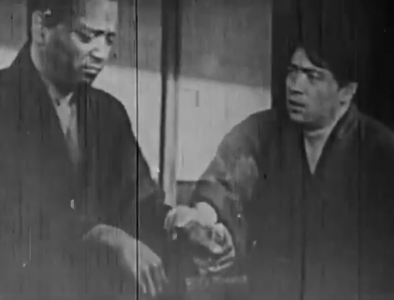
This is perhaps the only film Uchida ever made in which he engaged in what Hollywood calls “stunt casting”: in the roles of the two main male characters, Hyōtarō and the adult Hyōkichi, Uchida cast the same actor – his favorite performer of the period, Kosugi Isamu. This required the time-consuming use of special effects to present the actor as both characters in the same frame. (However, since the two characters are separated for most of the movie, the scenes in which they actually appear together are relatively few.) In one scene occurring about 13 minutes into the film, the son is even seen gently placing his hand on the father’s arm: an “impossible” shot. Despite the sophisticated (for the time) use of double-exposure, Hyōkichi’s right arm is seen as transparent, as if belonging to a ghost, inadvertently revealing the trick, at least to modern eyes.
Why did Uchida do this, when there were any number of more-or-less competent character actors who could have effectively played the old yakuza opposite Kosugi’s Hyōkichi?9 Keiko McDonald claims that Uchida sought to demonstrate by casting the same actor in both parts the similarities in personality and values between Hyōtarō and Hyōkichi: “like father, like son.” She quotes critic Shigeno Tatsuhiko, who says that this device served to “project a straightforward image of the father’s character passed on to the son and emulated by him.”10
The movie’s tone is consistently ironic. The values which Hyōtarō instills in his impressionable son – integrity, courage, self-reliance – are presented as worthy, even admirable, in the abstract, but totally out-of-step with the materialistic values of rapidly Westernizing early-20th Century Japan. Hyōtarō thus virtually guarantees his son’s disillusionment as an adult.
Furthermore, there’s a fatal contradiction in the father’s “education” of his son. He constantly demands that Hyōkichi be “his own man” and not conform to the will or expectations of others. At the same time, he insists that the boy, and later the young man, follow his advice to the letter, and conform completely to his expectations.
For example, when Hyōkichi decides to go to university, Hyōtarō forbids him to accept help from anyone, even from close friends, while at the same time contradictorily insisting that he himself should pay all of Hyōkichi’s expenses.11 It seems to me very unlikely that the son is unaware that his father can ill-afford to do this, yet he fails to stick to his original resolve to pay his own way through college. This is probably not insensitivity on Hyōkichi’s part so much as simple weakness of will: he lacks the moral strength to defy his father, even for the father’s – and the Aonari family’s – own good. Only at the end does he take personal responsibility by allowing his father’s creditors, even the vile Jin, to take possession of Tatsumiya, and resolving to make his own way without inherited resources.12
Whatever Uchida’s motive, the unusual casting of the same actor in two roles seems to me redeemed by the fine performances Kosugi gives in both roles, particularly as Hyōtarō: he successfully conveys both the old man’s authoritarian harshness and his boundless affection for, and pride in, his only son.

The tree we see at the beginning and at various times later in the narrative is the symbol of the Aonari family and its legacy. Hyōtarō’s pride in the tree reflects his pride in himself and his lineage. When the boy Hyōkichi manages to climb the tree despite his fears, this act symbolizes his adoption of his father’s values… to his own eventual detriment. Nevertheless, the kindly monk’s comment, “Tatsumiya’s tree may have withered, but a bud survives,” hints that the Aonari legacy has not been totally destroyed with the loss of the estate, so long as Hyōkichi exists to carry it on.
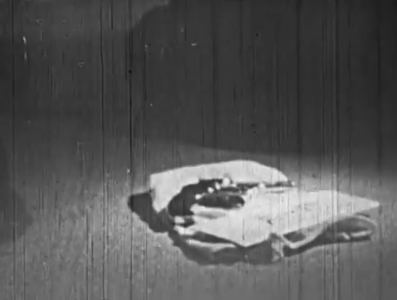
The pistol that Hyōtarō gives to Hyōkichi serves as an obvious phallic symbol and a fitting image for both characters’ patriarchal values. It also serves as a bond between the son and his spiritual brother, Kira Tsune, who presents him with the pistol after the father’s death.
However, the movie contradicts the principle of “Chekhov’s gun,” which asserts – based on the advice to young playwrights that appeared in Anton Chekhov’s letters –that if a gun is introduced at some time early in a story, it must eventually be fired during the course of the narrative. Near the end of the story, Hyōtarō’s gun is utilized, unfired, by the bereaved son to frighten away the cowardly Jin and the creditor Uezono when they tactlessly demand that he pay his father’s debt even before the funeral is over. But he can’t use it to kill his father’s creditors, and so must resign himself to the loss of his father’s estate. Thus, the gun becomes an ironic symbol not of the protagonist’s power, but of his impotence.
(Continued on page 2)